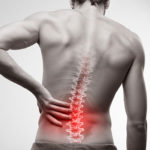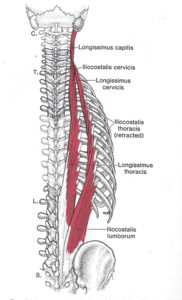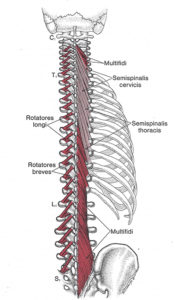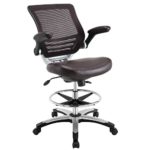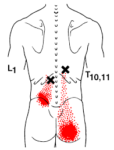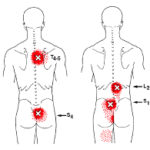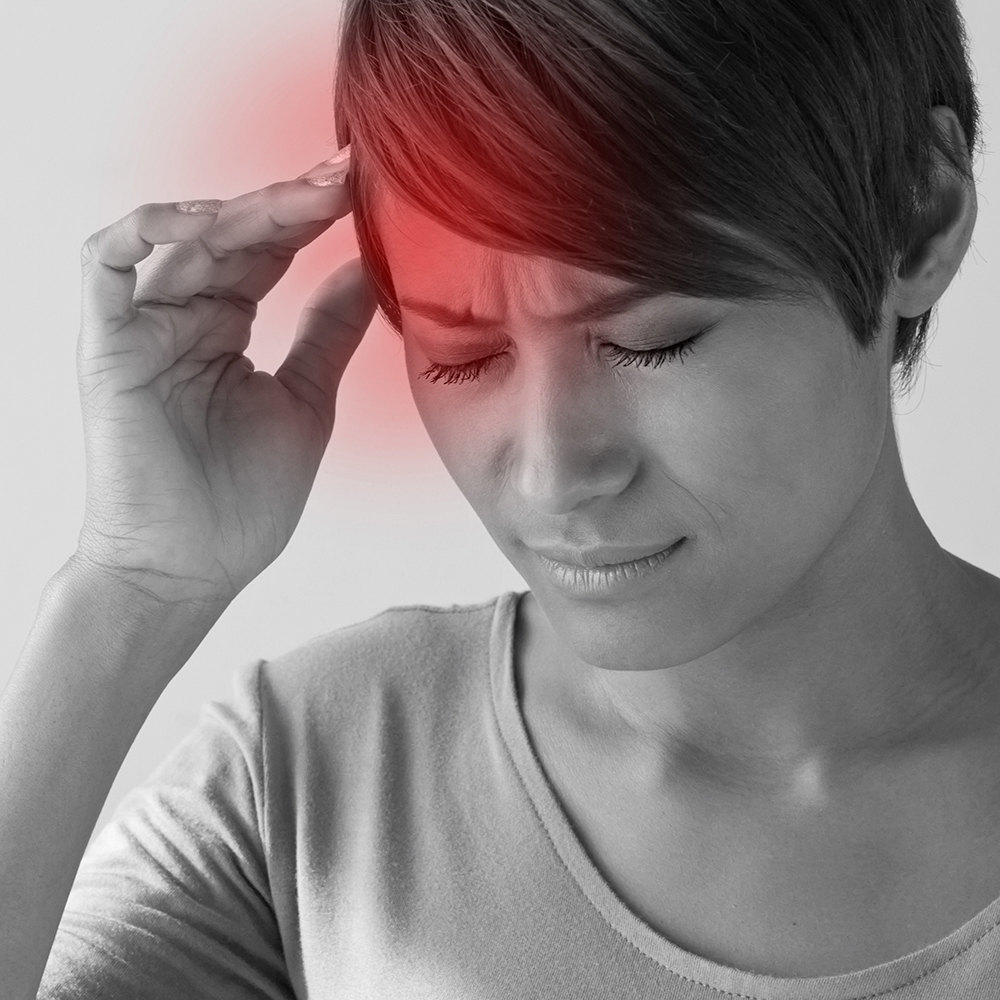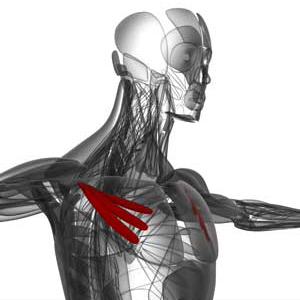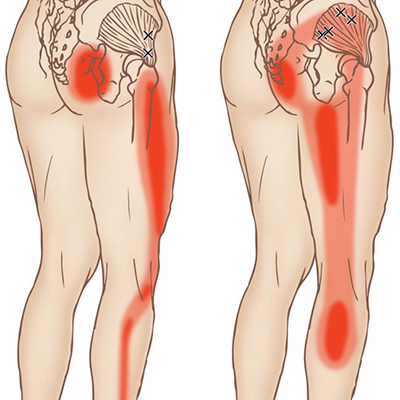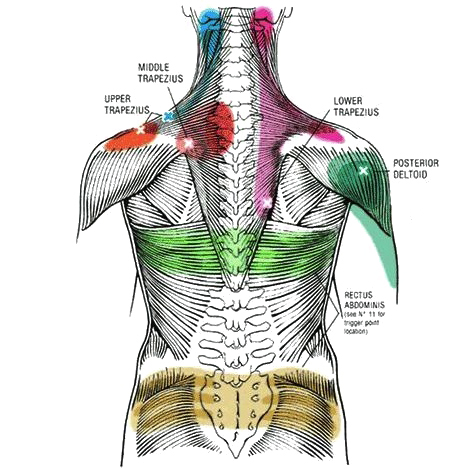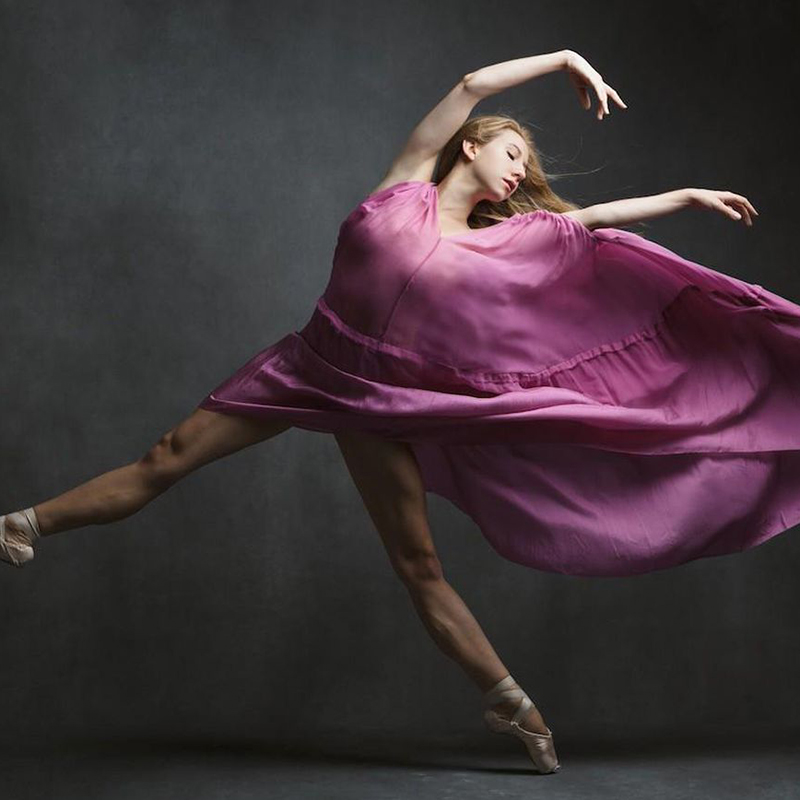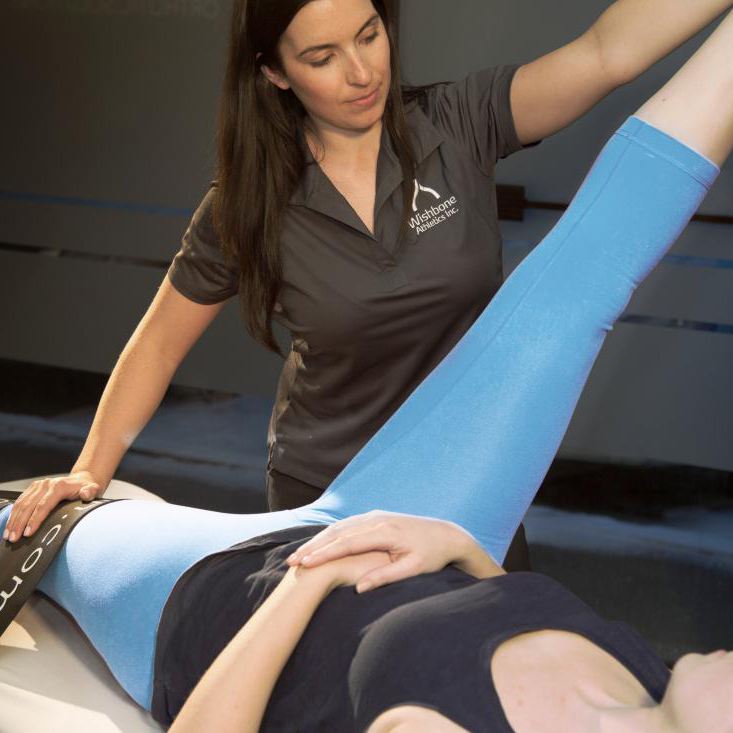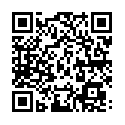Deep vs Superfical Paraspinals
The chronic low back pain multifidi and longissimus cause can be severe. Of the seven primary muscle groups that refer pain into the low back these are the only two of them live in the lumbar spine.
Note that the pain of trigger points in the multifidi remain as localized ‘spots’. You may have just one, or there may be several trigger points in different multifidi at different points along the spine. Trigger points in longissimus usually refers pain into the glutes, sometimes, high enough to feel something like low back pain.
The truth is, much of the soft tissue surrounding the lumbar spine is connective tissue anyway. Most of the muscles that influence this area are located elsewhere in the body. And, in just one study, of 283 patients referred for chronic intractable lumbar pain, 96% had trigger points (Rosomoff, Fishbain, Goldberg – 1990).
Superficial Paraspinals
Longissimus is the long, thick muscle visible on both sides of the spine in well muscled individuals. Sometimes we can also see iliocostalis curving off to the side. We use these muscles to assist our glutes and hamstrings in spinal extension. We also use them for extension of the leg at the hip. When we think of big, strong back muscles, these are the ones.
The over-development of the superficial paraspinals often happens as part of postural patterns or workout routines that don’t emphasize the deeper paraspinals. For example, let’s say your workout routine emphasizes deadlifts and squats. You are building up your spinal erectors, including longissimus, glutes and hamstrings.
This can also happen through inactivity. When the smaller, deep paraspinals begin to atrophy, they are not able to effectively stabilize our spines. This makes the larger, superficial paraspinals work harder in an attempt to make up the difference.
The Deep Paraspinals
In contrast, the semi-spinalis, multifidi, and rotatores are a collection of dozens of very small muscles, deep within the back, that run from vertebrae to vertebrae. We use these muscles to make smaller, more subtle movements of the spine. The smallest, running from 1-2 vertabrae are the rotatores, the multifidi run from 3-4 vertabrae and the semispinalis run rin 5-8 vertabrae.
One of the primary functions of the deep paraspinals is to maintain postural stability of our vertebral column. In cases of chronic back pain or general deconditioning, the deep paraspinals become weak. The body compensates by activating the superficial paraspinals to help maintain stability.
For athletes and other well-conditioned people, remember those deadlifts? If they aren’t balanced with smaller movements, the multifidi are neglected and will be underdeveloped. The multifidi and rotatores get a better workout from activities like dancing, yoga, swimming and tennis.
This becomes especially problematic if we do something to aggravate our spinal erectors so they cannot perform their primary function of spinal extension.
The Perils of Sitting
 When we sit our hips and knees are jacknifed, leading to tight hip flexors and hamstrings. Our glutes are aggravated from the constant pressure of sitting. Our QL is unhappy because we tend to slouch to one side.
When we sit our hips and knees are jacknifed, leading to tight hip flexors and hamstrings. Our glutes are aggravated from the constant pressure of sitting. Our QL is unhappy because we tend to slouch to one side.
Standing desks are popular and a significant improvement for most people. However, standing all day will tend to engage our spinal erectors and can activate trigger points. The spine typically remains fairly stiff and the multifidi don’t get much of a work out. We do need to sit.
Unfortunately, most of our chairs are also designed incorrectly. We’ve seen a profusion of different chair styles come and go for decades. However, foundational research was done on this over 70 years ago.
We’ve know that chairs should have a sloped backrest with lumbar support and a slightly hollowed out seat. It should be firm (not solid wood or plastic). The feet should rest flat on the floor or a foot rest.
A chair similar to this “Modway Adjustable Edge Drafting Chair” has it all. It is high enough for a standing desk, the seat can be adjust to tilt forward and it has arms that are also adjustable. A rocking footrest is also a great addition to most workstations.
Trigger points in the paraspinal muscles can be activated by sudden overload. A whiplash-type accident can rapidly stretch spinal muscles that are protectively stiffened, activating trigger points in them. More often, paraspinal trigger points are activated by sustained overload in a stooped posture (think pulling weeds…).
Prolonged immobility, such as driving or sitting on an airplane with the seat belt fastened can also activate multifidi TrPs. It is worth noting that in testing of the electrical activity of these muscles when sitting still, EVERYONE developed increased tension in just over 30 minutes (Lundervold – 1951).
In the event of a herniation of a lumbar disc, the some of the contents of that disc may ooze out. Unfortunately, this material is neurotoxic and creates inflammation at the affected spinal level. This inflammation often causes the multifidi to spasm, further weakening the support for the spine at that level. As we move higher up the spine, the pain of multifidi activations is often more localized and not associated with more complex pain patterns and referrals to other areas.
There are a variety of stretching exercises for the lower back. The long sit is a classic passive stretch. Do not try to reach vigorously for your toes.
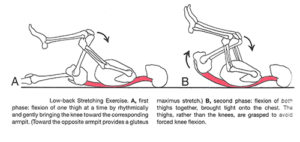 The reclining, rocking knees to chest stretch is also effective. For many years, we have been taught to strengthen the abs to support the low back. However, this type of ab work is often done incorrectly and will be covered in another post.
The reclining, rocking knees to chest stretch is also effective. For many years, we have been taught to strengthen the abs to support the low back. However, this type of ab work is often done incorrectly and will be covered in another post.
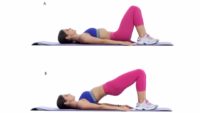 For most, it is at least as important to strengthen the multifidi. One easy way to do this is when doing a basic glute bridge.
For most, it is at least as important to strengthen the multifidi. One easy way to do this is when doing a basic glute bridge.
When coming down, lower the spine in a very slow, controlled manner. Imagine that you are laying down one vertebra at a time. The glute strengthening will also offload your spinal erectors.
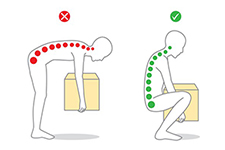 Naturally, improper lifting is a significant stressor. If we don’t remind ourselves how to lift heavy objects, low back problems will continue and worsen. Hold the object close to your body with the pelvis tucked in. It is especially hazardous for the lower spine to twist while lifting or pulling. It is much safer to rotate the body and face the load squarely or lift first and then pivot.
Naturally, improper lifting is a significant stressor. If we don’t remind ourselves how to lift heavy objects, low back problems will continue and worsen. Hold the object close to your body with the pelvis tucked in. It is especially hazardous for the lower spine to twist while lifting or pulling. It is much safer to rotate the body and face the load squarely or lift first and then pivot.
What Else Makes This Type of Low Back Pain Worse?
A soft mattress that sags in the middle aggravates tension in the low back muscles. There are a variety of different mattress styles but any new, firm mattress is an improvement over a soft, sagging one. When sleeping on the side, a pillow between the lower legs can reduces torsion of the hips and lumbar spine during sleep.
How Can I Help Myself With Low Back Pain?
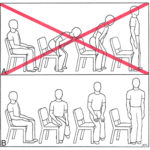 We might consider some changes in body mechanics to reduce the chronic low back pain multifidi and longissimus trigger points cause.
We might consider some changes in body mechanics to reduce the chronic low back pain multifidi and longissimus trigger points cause.
For instance, it may help to learn to rise from a couch or chair without arms using the “Sit to Stand” method. First, move your hips forward to the front of the chair seat. Then, turn the body and hips to the side. Place one foot beneath the edge of the chair and finally, hold your torso erect while you straighten the knees and hips, lifting the body.
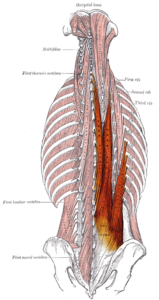 Collectively, the iliocostalis, longissimus and spinalis are referred to as the erector spinae group. This is because their primary function is to extend the spine. This group is more superficial, with fibers running vertically and is larger and stronger than the deeper paraspinal group. These muscles are adapted for larger, slower movements requiring more strength.
Collectively, the iliocostalis, longissimus and spinalis are referred to as the erector spinae group. This is because their primary function is to extend the spine. This group is more superficial, with fibers running vertically and is larger and stronger than the deeper paraspinal group. These muscles are adapted for larger, slower movements requiring more strength.
The semispinalis, multifidi and rotatores are oriented and run diagonally. They progress in this order from more superficial to more deep and from larger to smaller. These smaller muscles form a sort of basketwork of decreasing size. The rotatores span just a one or two spinal levels. The multifidi typically span 3-4 levels and the semispinalis spans 5-8 levels. At the longest and most vertical of the group, semispinalis is transitional and behaves much like the longissimus segment lying just above it.
Longissimus
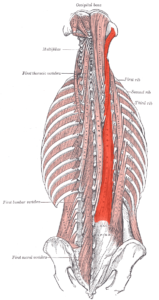 The longissimus thoracis et lumborum is the intermediate and largest of the continuations of the erector spinae. It arises from common fascial root with iliocostalis.
The longissimus thoracis et lumborum is the intermediate and largest of the continuations of the erector spinae. It arises from common fascial root with iliocostalis.
In the lumbar region (longissimus lumborum), where it is as yet blended with the iliocostalis, some of its fibers are attached to the whole length of the posterior surfaces of the transverse processes and the accessory processes of the lumbar vertebrae, and to the anterior layer of the lumbodorsal fascia.
In the thoracic region (longissimus thoracis), it is inserted, by rounded tendons, into the tips of the transverse processes of all the thoracic vertebrae, and by fleshy processes into the lower nine or ten ribs between their tubercles and angles.
Iliocostalis
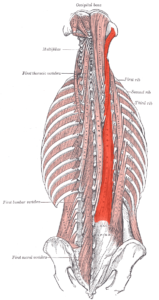 The iliocostalis is the muscle immediately lateral to the longissimus that is the nearest to the furrow that separates the epaxial muscles from the hypaxial. It lies very deep to the fleshy portion of the serratus posterior muscle.
The iliocostalis is the muscle immediately lateral to the longissimus that is the nearest to the furrow that separates the epaxial muscles from the hypaxial. It lies very deep to the fleshy portion of the serratus posterior muscle.
There are three segments of iliocostalis, each located higher or lower on the spine and each with their own referral patterns. In general, iliocostalis lumborum is the segment we deal with most often when encountering low back and buttocks pain.
The iliocostalis cervicis arises from the angles of the third, fourth, fifth, and sixth ribs, and is inserted into the posterior tubercles of the transverse processes of the fourth, fifth, and sixth cervical vertebrae.
The iliocostalis dorsi arises by flattened tendons from the upper borders of the angles of the lower six ribs medial to the tendons of insertion of the iliocostalis lumborum; these become muscular, and are inserted into the upper borders of the angles of the upper six ribs and into the back of the transverse process of the seventh cervical vertebra.
The iliocostalis lumborum (iliocostalis muscle) is inserted, by six or seven flattened tendons, into the inferior borders of the angles of the lower six or seven ribs.
Spinalis
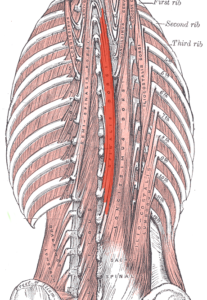 The spinalis is a portion of the erector spinae, a bundle of muscles and tendons, located nearest to the spine. It is divided into three parts: Spinalis dorsi, spinalis cervicis, and spinalis capitis. The upper and lower sections are inconsistent and blended with other tissues, but the thoracic section of spinalis dorsi is palpable.
The spinalis is a portion of the erector spinae, a bundle of muscles and tendons, located nearest to the spine. It is divided into three parts: Spinalis dorsi, spinalis cervicis, and spinalis capitis. The upper and lower sections are inconsistent and blended with other tissues, but the thoracic section of spinalis dorsi is palpable.
Spinalis dorsi, the medial continuation of the sacrospinalis, is scarcely separable as a distinct muscle. It is situated at the medial side of the longissimus dorsi, and is intimately blended with it; it arises by three or four tendons from the spinous processes of the first two lumbar and the last two thoracic vertebrae: these, uniting, form a small muscle which is inserted by separate tendons into the spinous processes of the upper thoracic vertebrae, the number varying from four to eight.
It is intimately united with the semispinalis dorsi, situated beneath it.
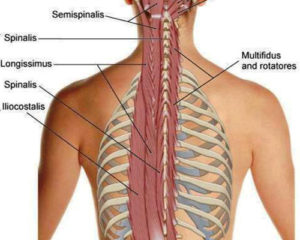 Collectively, the smaller, deeper paraspinal muscles are called transversospinales because they run from the transverse process of one vertabra to the spinous process of another. Their combined action is rotation and extension of the vertebral column.
Collectively, the smaller, deeper paraspinal muscles are called transversospinales because they run from the transverse process of one vertabra to the spinous process of another. Their combined action is rotation and extension of the vertebral column.
These muscles are small and have a poor mechanical advantage for contributing to motion. However, they are essential for fine movements of the spine and for stability of the spinal column.
They include:
- the three semispinalis muscles, spanning 5-8 vertebral segments
- multifidus, spanning 3-4 vertebral segments
- rotatores, spanning 1-2 vertebral segments
Semispinalis
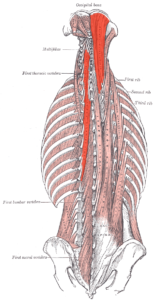 The semispinalis muscles are the most superficial group of three muscles belonging to the transversospinales. These are the semispinalis capitis, the semispinalis cervicis and the semispinalis thoracis.
The semispinalis muscles are the most superficial group of three muscles belonging to the transversospinales. These are the semispinalis capitis, the semispinalis cervicis and the semispinalis thoracis.
The semispinalis thoracis muscle consists of thin, narrow, fleshy fasciculi, interposed between tendons of considerable length. It arises by a series of small tendons from the transverse processes of the sixth to the tenth thoracic vertebrae, and is inserted, by tendons, into the spinous processes of the upper four thoracic and lower two cervical vertebrae.
The semispinalis cervicis arises by a series of tendinous and fleshy fibers from the transverse processes of the upper five or six thoracic vertebrae, and is inserted into the cervical spinous processes, from the axis to the fifth cervical vertebrae inclusive. The semispinalis cervicis is thicker than the semispinalis thoracis. The fasciculus connected with the axis is the largest, and is chiefly muscular in structure.
The semispinalis capitis is situated at the upper and back part of the neck, deep to the splenius, and medial to the longissimus cervicis and longissimus capitis. It arises by a series of tendons from the tips of the transverse processes of the upper six or seven thoracic and the seventh cervical vertebrae, and from the articular processes of the three cervical vertebrae above this (C4-C6).
The tendons, uniting, form a broad muscle, which passes upward, and is inserted between the superior and inferior nuchal lines of the occipital bone. It lies deep to the trapezius muscle and can be palpated as a firm round muscle mass just lateral to the cervical spinous processes.
Multifidi
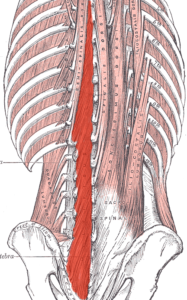 The multifidus (multifidus spinae : pl. multifidi ) muscle consists of a number of fleshy and tendinous slips or fasciculi, which fill up the groove on either side of the spinous processes of the vertebrae, from the sacrum to the axis. While very thin, the Multifidus muscle plays an important role in stabilizing the joints within the spine. The multifidus is one of the transversospinales.
The multifidus (multifidus spinae : pl. multifidi ) muscle consists of a number of fleshy and tendinous slips or fasciculi, which fill up the groove on either side of the spinous processes of the vertebrae, from the sacrum to the axis. While very thin, the Multifidus muscle plays an important role in stabilizing the joints within the spine. The multifidus is one of the transversospinales.
Located just superficially to the spine itself, the multifidus muscle spans three joint segments and works to stabilize these joints at each level.
The stiffness and stability makes each vertebra work more effectively, and reduces the degeneration of the joint structures caused by friction from normal physical activity.
These fasciculi arise:
- in the sacral region: from the back of the sacrum, as low as the fourth sacral foramen, from the aponeurosis of origin of the sacrospinalis, from the medial surface of the posterior superior iliac spine, and from the posterior sacroiliac ligaments.
- in the lumbar region: from all the mamillary processes.
- in the thoracic region: from all the transverse processes.
- in the cervical region: from the articular processes of the lower four vertebrae.
Each fasciculus, passing obliquely upward and medially, is inserted into the whole length of the spinous process of one of the vertebræ above.
These fasciculi vary in length: the most superficial, the longest, pass from one vertebra to the third or fourth above; those next in order run from one vertebra to the second or third above; while the deepest connect two adjacent vertebrae.
The multifidus lies deep relative to the spinal erectors, transverse abdominis, abdominal internal oblique muscle and abdominal external oblique muscle.
Rotatores
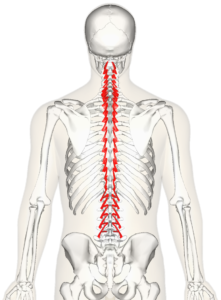 The rotatores muscles (rotatores spinae muscles) lie beneath the multifidus and are present in all spinal regions but are most prominent in the thoracic region; they are eleven in number on either side.
The rotatores muscles (rotatores spinae muscles) lie beneath the multifidus and are present in all spinal regions but are most prominent in the thoracic region; they are eleven in number on either side.
Each muscle is small and somewhat quadrilateral in form; it arises from the superior and posterior part of the transverse process, and is inserted into the lower border and lateral surface of the lamina of the vertebra above, the fibers extending as far as the root of the spinous process.
The first thoracic rotatores muscle is found between the first and second thoracic vertebrae; the last, between the eleventh and twelfth. Sometimes the number of these muscles is diminished by the absence of one or more from the upper or lower end. The Rotatores muscles have a high density of proprioceptors and have been implicated in postural control.
Superficial Paraspinals
The superficial paraspinals, or spinal erectors, are strong extensors of the spinal column. However, rather than actively extending our spines, the spinal erectors act eccentrically most of the time.
For example, we do not frequently lift something heavy and when we do, we try not to use our back muscles. But each time we bend over, even if just to pick up a tissue, we need to use our spinal erectors eccentrically to control the descent of our trunk. Muscles are especially vulnerable to injury during strong eccentric contractions. When we return to upright posture, we use a concentric contraction of both sides of the spinal erectors.
When just we concentrically contract our spinal erectors on just one side, it assists in flexion towards that side. The opposite side engages in an eccentric contract to control that movement.
Deep Paraspinals
How Can a Therapist Help You With Low Back Pain?
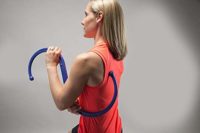 Reaching specific multifidi and longissimus yourself can be difficult without a tool such as the backknobber. This tool provides the combination of leverage and control that is necessary.
Reaching specific multifidi and longissimus yourself can be difficult without a tool such as the backknobber. This tool provides the combination of leverage and control that is necessary.
Trigger points in these muscles often occur as part of a larger pattern of imbalance and myofascial dysfunction. Most of us are busy, so designing a program that will provide the most benefit with the least time and effort expended is important.
In addition, skeletal variations such as leg length differences, asymmetry in the pelvis or Morton’s foot structure can perpetuate dysfunction in the longissimus and multifidi. A professional can help evaluate these factors and recommend simple corrective actions. For example, we can recommend an appropriate heel or ischial (butt) lift on the smaller side or measure you for provide posture control insoles.
Professional Treatment With Us
Take some time. Treat yourself. You deserve it.
Book a treatment this month and receive 20% off a three session package.
Janet was great. FANTASTIC person who knew how to treat and deal with my conditions. Very informative. Finally, someone who knew what I was talking about.
Really Good
It was interesting, and helpful for my IT band and hip
My experience was wonderful. Janet was very kind and attentive. I felt great after my session and would recommend to try it out.
The lady that assisted me was awesome! I suffer from fibromyalgia and when I left I felt like a brand new person! I plan to return when I get time!
Janet was great - knowledgeable and she found all my "hot spots."
Seriously, if you are looking for massage therapy that actually does your body good--that changes its function for the better and actually makes pain go away--then this is the place you need to come. Not Massage Envy. Not a chiropractor. You need trigger point from knowledgeable experts in the craft.
If your have pain in any part of your body this is the place to go. It focus on the muscles where the pain is. you will feel like a new person. Awesome will be returning. Thanks nice friendly and attentive
amazing!!!
I felt so much better after my appointment. Thank you and thanks for the self care tips!
Experienced therapist. Feel great after appointment...
Highly recommended!
What a great experience. The provider was able to recommend things I can do to improve my pain. Address issues I didn't even share with her that she was able to tell just by her exam and treating me for what i went for. Will be back. Feeling grateful
I spent so much money on chiropractors. This is much better. Everybody should try it out.
Beautiful, relaxing setting. Therapist was knowledgable and professional. I'll be going back. Thank you.
Janet is very informative. I loved that she explained which muscles/groups she was working on. I learned a lot about my posture and why some of my muscles are not activating. She also provided me with a list of considerations and excercises to improve my posture. I will be back!
Janet has a unique gift and talent in trigger point therapy. I’m definitely seeing her again!
I loved my experience. Janet is extremely knowledgeable in a vary wide variety of conditions. She is thorough and attentive. Makes you feel right at home!
It's like an hour of physical therapy (the good parts of P.T. where they massage you and stretch you). She also takes time to explain some ways to help your specific issues. Highly recommend!
Janet is very knowledgeable and informative. She thoroughly explains where you have weakness and what muscles are over compensating. She gives exercises, stretches, or everyday changes you can make to help you are progress on your own. I highly recommend a visit!
Janet was very knowledgeable and never in a hurry. She took her time explaining every little detail, great service
Felt much better after the trigger point massage, highly recommend.
Excellent
What About My Pain?
Clearly, everyone is different. Many of us have additional challenges and complications. Naturally, we tailor our treatment plans to the individual. However, there are common foundations in this work with everyone.
Fortunately, if you are having similar issues, you may find that a just few treatment sessions helps! We will identify and treat root causes of your individual case.
Clearly, everyone is different. Many of us have additional challenges and complications. Naturally, we tailor our treatment plans to the individual. However, there are common foundations in this work with everyone.
We are licensed professionals. In addition, we all have additional training and certifications in advanced techniques. For instance, this includes trigger point therapy, fascial stretching, neuromuscular and movement therapy. Also we offer kinesio taping, myofascial release, cupping, acoustic compression, self-care classes and more. In fact, we often combine several of these techniques into a single session..
Of course, no one wants chronic pain! Fortunately, can work together with you to help sort out the issues.
Click here or all us at 630-858-0000 today to make an appointment!
More info at: WestSubPainRelief.com
You can also take a picture of this QR code with another phone and share or view the entire article:
If reading from a pdf or printout, you will find links and videos at: https://WestSubPainRelief.com/low-back-pain-paraspinals

